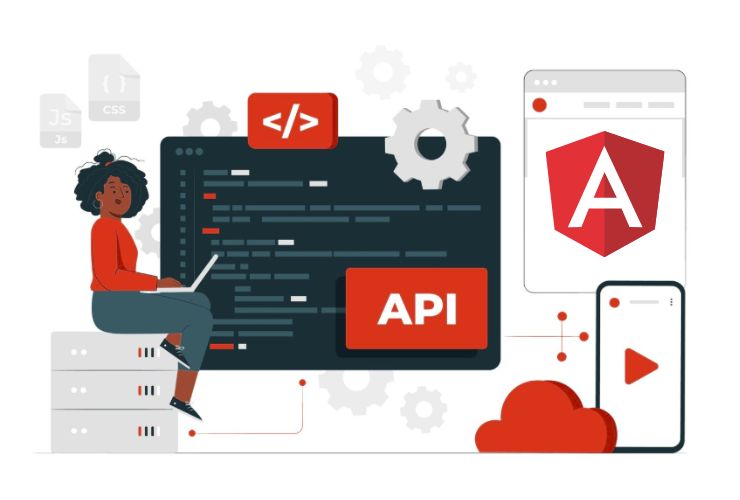Dependency Injection (DI) shapes how Angular applications are structured. It plays a vital role in keeping code clean and manageable, especially as projects grow more complex.
DI provides us with a solution to provide components and services with the objects they need without putting those objects inside them. This results in more refined, decoupled code that is less complex to test, to keep up and running, and to restructure.
What Is Dependency Injection?
Dependency Injection in its most straightforward form is a design pattern in which dependencies (services or objects) are pushed into a class instead of a class instantiating them. It keeps each class’s concerns as low as possible and makes it able to rely on external systems that will provide it with what it needs.
In Angular, the DI is embedded in the framework. One can register services and let Angular automatically inject them wherever necessary. This promotes a clean, modular way that’s easy to work with over a big application.
Why Angular Uses Dependency Injection
Angular applications are typically composed of many small, one-purpose pieces and services. These components, put together, form an entire system. Dependency injection facilitates this modular structure by:
- Simplifying classes from dependencies, freeing tight coupling
- Enhanced testability by enabling developers to swap actual dependencies with mocks or stubs
- Making configuration tighter and sharing resources between different parts of the app
- Enabling scalability with elastic service scopes and hierarchical injectors
The shared DI system eliminates boilerplate code to wire up instances manually. Angular does that for you.
How Angular Services Fit Into Dependency Injection
Services are the core of Angular’s DI system. They are utilized as repositories for shared logic, data, or functionality that might be required by multiple components. Instead of duplicating code or logic all over your app, you can declare a service and inject it where necessary.
A few examples of services include:
- Data retrieval and API management
- Business logic like calculations or workflows
- Application configuration or environment variables
- Utility functions like validation or formatting
This is both an improvement in maintainability and reusability because any change of the service logic will be visible in all the parts making use of it.
The Angular Injector
The Angular injector is the one that initiates dependency injection. It’s responsible for:
- Creating instances of services
- Maintaining a registry of providers
- Returning an appropriate instance of a service to requesting classes
Angular uses a hierarchical injector architecture. This means that injectors can be at different levels in the app:
- Root Injector: A singleton object that provides services across the app.
- Component Injector: Limited to a component and its descendants, convenient for scoped services.
This flexibility lets developers control service sharing or isolation, conserve memory, and maintain clean application boundaries.
Constructor Injection: The Angular Way
Angular depends primarily on constructor injection to inject dependencies. When Angular instantiates a component or service, it looks at its constructor and automatically resolves and injects the dependencies it needs.
The strategy is simple yet potent:
- It presents dependencies to developers at a glance
- It encourages explicit design, making it clear what a class has a dependency on
- It ensures consistency in your application
Constructor-based DI harmonizes with TypeScript’s strengths of robust typing and reflection of metadata, which allow Angular to determine what dependencies need to be resolved.
Real-World Benefits of Using Dependency Injection in Angular
Effective use of DI in Angular applications unlocks numerous real-world advantages:
- Nourished, leaner components focused on presentation, not on logic
- Faster development cycles via reusable services
- Better test coverage with mockable services within reach
- Scaleable architecture that grows along with the app
- Enhanced team collaboration by service contracts on which several teams can rely
Naturally designed applications have a propensity to decouple concerns in layers. DI maintains that decoupling, reducing bugs, duplication, and inconsistencies.
Common Usage of Dependency Injection in Angular Applications
Dependency injection is used everywhere in Angular. Some of the common usage are:
- API communication: Dependency injection for HTTP services for RESTful communication
- Authentication/Authorization: Dependency injection for auth services for handling login states
- State management: Injecting services to manage application state between components
- Utility services: Injecting reusable logic such as date formatting, logging, or validation
- Dynamic configurations: Injecting config values depending on environment or user role
Regardless of whether you’re dealing with user information or app-level settings, DI simplifies things.
Best Practices for Angular Dependency Injection
To get the most out of Angular’s DI system:
- Use @Injectable() consistently across all services and classes that need injection
- Scope services wisely, use root-level for common instances and component-level when isolation is necessary
- Avoid service overloading—don’t overstuff logic into a single service
- Use interfaces or abstract classes when injecting alternative implementations
- Leverage Angular’s providedIn syntax to simplify service lifetimes
By adhering to these conventions, your application is simpler to maintain, especially in team environments or big projects.
Final Thoughts
Dependency Injection is not just an Angular feature—it’s a fundamental part of its design philosophy. Understanding how DI works lets you take full advantage of Angular, allowing you to build apps that are scalable, efficient, and a pleasure to test.
No matter if you are building a simple web application or a sophisticated enterprise-class system, understanding Angular’s DI system will go a long way in improving the quality and design of your code. It encourages reusability, testability, and consistency and is therefore one of the most useful tools in the arsenal of any Angular developer.
If you’re committed to working with Angular, it’s worth learning to do dependency injection effectively. The reward is neater, more manageable apps—and a lot less agonizing development..
Contact Us Today













 Database Development
Database Development












































